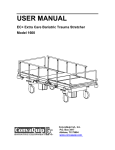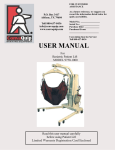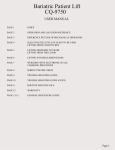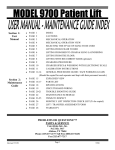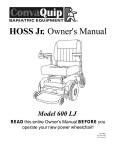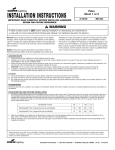Download ConvaTec USA 900EC User's Manual
Transcript
OPERATION and SERVICE MANUAL EC TRANS. CHAIR MODEL 900EC THE SERIAL NUMBER WILL BE FOUND ON THE LOWER FRAME AT THE HEAD END. RECORD THE NUMBER BELOW: SERIAL NUMBER: DATE OF PURCHASE ConvaQuip Ind., Inc. P.O. Box 3417 Abilene, TX 79604 800-637-8436 / Fax 325-677-7217 www.convaquip.com Form 900EC Manual TABLE OF CONTENTS CONTENTS 1.0 IMPORTANT INSTRUCTIONS 2.0 GENERAL WARNINGS AND PRECAUTIONS 3.0 MODEL 900EC 4.0 OPERATING THE CHAIR 4.1 OPERATION OF STEER/BRAKE 4.2 USING THE 4 - CASTER FREE FUNCTION 4.3 APPLYING THE BRAKES 4.4 ADJUSTING THE ARMREST 4.5 RAISING THE SURFACE 4.6 I.V. SOCKETS AND STORAGE 4.7 HANDSET OPERATION 5.0 DIAGNOSTICS & REPAIR 6.0 CLEANING & MAINTENANCE 7.0 SPECIFICATIONS 8.0 LIMITED WARRANTY 1.0 IMPORTANT INSTRUCTIONS Safety First: The primary concern of ConvaQuip is that this equipment be operated and maintained with the safety of the user in mind. To assure safe and reliable operation. 2.0 1. Read this manual before operating your equipment. 2. It is the responsibility of the purchaser to assure that appropriate personnel are in formed on the contents of this manual. 3. Be sure that you understand the instructions contained in this manual before at tempting to operate this equipment. 4. This manual should remain permanently af?xed to this equipment. GENERAL WARNINGS Throughout this manual there are warnings that call attention to particular procedures. The items are used as follows: WARNING A WARNING is used for an operating procedure, practice, or condition which, if not fol lowed correctly, could result in personal injury. For your personal safety and that of your personnel, WARNINGS are repeated here. Become throughly familiar with them and observe them at all times. 1. Failure to properly install accessories could result in personal injury or equip ment damage. 2. Failure to engage the steering swivel lock while transporting patients could result in personal injury or equipment damage. 3. Failure to seek assistance when transporting patients up or down inclines could result in loss of control and subsequent personal injury or equipment damage. 4. Failure to make sure the chair does not roll with the brakes engaged could result in personal injury or equipment damage. 5. Failure to engage the brakes when chair is unattended could result in personal injury or equipment damage. 6. Do not use the footrest as a step when getting into or out of the chair. The foot rest should be in its folded position to avoid tripping the patient. This may result sult in personal injury or or result in personal injury or equipment damage. 7. NEVER exceed the weight limit of 850 pounds exceeding weight limit may cause personal damage or equipment damage. 8. Failure to use side rails and not testing the latch could result in personal injury. 9. Caster locks are not designed to stop the chair in motion. 10. Take special care to lock the casters securely when transferring patient to or from the chair. 11. Do not allow the patient to sit on the chair when it is in the prone position. Never sit or lean on the headrest or the legrest when the chair is in the prone position. Caution: Failure to observe these safety precautions may result in personal injury or mechanical failure. Read all instructions carefully before using the chair. . . . . . . . Weight Limit: Never exceed the weight limit of the chair (combined weight of user and items on chair). Exceeding weight limit may cause the chair to fail. The weight capacity of each chair is shown on the back rest and on the serial number label. Power Requirements: Electrical hazard may occur if the chair is plugged into an inadequate power supply. A power source of 120 VAC, 50 to 60Hz, with a capacity of at least 15 amps must be available to operate the chair. A three-wire grounded receptacle must be supplied. A (ground fault circuit interrupter) GFCI is recommended. (maximum current drawn by the chair is 9 amps) Battery Back-up: The system’s battery automatically charges when the power cord is plugged into an electric outlet. If electrical power is lost, the battery maintains a charge to allow the chair to be operated. However, if the power is off and the chair is operated for an extended time, the battery will lose its charge, the actuators will not function and the chair cannot be raised or lowered. Do not service this device without ?rst unplugging the power cord and battery. Caution: Chair parts can move even with power cord unplugged, because of backup battery. Make sure the control module and the handset cords are properly positioned before operating the chair. Do not allow either of these cords to get caught in the moving members of the chair. Do not operate this device if the power cord or any of the cords between the control module and the associated parts are cut, frayed or loosely connected. Do not use a chair with any missing or damaged parts. 3.0 MODEL 900EC The backrest is adjustable from 0 - 60°. This chair is equipped with central steering and braking system operable from any corner of the chair. This facilitates patient transport. High density foam seat, leg and back cushions are covered with low shear fabric. 4.0 OPERATING THE CHAIR Operation of all features and functions prior to usage is essential to ensure that chair was not damaged in transit. 4.1 OPERATION OF STEERING/BRAKING The steering lock function allows you to easily steer the chair in a straight line. Only the left front caster has this function. Move the chair about 12” to put caster in trailing position and step on the green side of the pedal to lock the caster in steer mode. This action will keep the caster from swiveling and allow better forward movement of the chair. WARNING Failure to engage the steering swivel lock while transporting patients could result in personal injury or equipment damage. 4.2 USING THE 4 - CASTER FREE FUNCTION In the 4 - caster free mode, all four casters move independently, allowing the chair to be easily brought alongside a bed. In this mode all four casters are unlocked. WARNING Do not use the 4 - caster free function when moving a patient across an incline. The chair may roll down the incline and an injury may occur. 4.3 APPLYING THE BRAKES The central braking system locks all four wheels. To engage the brakes, go to any corner of the chassis and press the red side of pedal down approximately 45° to lock. After applying the brakes, try to lightly push the chair, it should not roll. If it does, remove the patient and discontinue using the chair until maintenance can be performed. WARNING Failure to make sure the chair does not roll with the brakes engaged could result in per sonal injury or equipment damage. WARNING Failure to engage the brakes when the chair is unattended could result in personal injury or equipment damage. 4.4 ADJUSTING THE ARMREST The armrest function as guardrails to prevent the patient from falling when the chair is in the prone position. They also function as the supports for the patients upper body when in a sitting position. After adjusting the armrest make sure the armrest is ?rmily locked in place. WARNING SIDE RAILS NEED TO BE IN UP POSITION ANY TIME A PATIENT IS IN CHAIR. 4.5 To either raise or lower the chair it must be in the prone position. The backrest must be all the way down and both legrest must be all the way up. The bottom row of buttons provide this feature with pushing one button. 4.6 The IV sockets are located on each side of the head end. The IV storage is located under the seat on the left side. 4.7 Handset Operation 1st row will raise and lower unit when in the prone position 2nd row will raise and lower the backrest 3rd row will raise and lower the left leg 4th row will raise and lower the right leg 5th row the up button will put unit in stretcher position; the down button will put unit in chair position To raise or lower the unit it must be in the stretcher position 5.0 DIAGNOSTICS & REPAIR PROBLEM CAUSE SOLUTION No functions operate No power to unit Check power cord Is it plugged into receptacle? Green Power-on light does not glow Electrical power cord not properly plugged into control module Power cord plugged in but no functions operate 6.0 Check cord for breaks. Check for power to receptacle Bad handset Replace handset Bad control module Replace control module CLEANING & MAINTENANCE The chair is subject to wear and tear resulting from the place, length, and other conditions of use. For longer use, periodically inspect all parts and have them replaced as needed. • • • • check the cushions for rips or tears check operation of the brake pedals check set screws on brake pedals check all bolts and nuts for tightness Your maintenance department should inspect the chair periodically ( at least every 6 months) for proper operation. Every six months minimum: • lubricate all slides and pivot points with FDA approved light grease • check all electrical wiring for any frays, kinks and or deterioration • ensure that lock and steer castor operate properly Any discrepancies noted during inspection must be corrected before using chair. CLEANING Any ?uid spilled on the seat, back or leg cushions should be removed as quickly as possible. All painted metal surfaces should be wiped with a clean, soft cloth weekly. All moving parts should be lubricated occasionally with light approved oils to help insure quiet, dependable operation. Before using any cleaning product, test it on the underside of the chair seat. Never use any vola tile ?uid (thinner, gasoline, etc) that could cause discoloration or deterioration. Use mild soap and water or a nonabrasive hospital grade detergent disinfectant to clean the chair. First, wet a cloth with the cleaning product and wring it dry, then gently wipe off the chair. 7.0 SPECIFICATIONS Product name: ConvaQuip EC TRANS. CHAIR Model: 900EC 850 LB. Capacity Dimensions: Overall Width 33 1/2” Overall Length chair position stretcher position 49 1/2” 75 1/2” Seat Width 28 1/2” Seat Depth 22” Back Angle 60 Degrees Chair Weight 280 LB LIMITED WARRANTY ConvaQuip will warrant your chair to be free from defects in material and workmanship under normal use and service for a period of two (2) years on parts & labor from date of the delivery to the original purchaser, except: the effective time period of this warranty is limited to one (1) year for cushions, wheels, tires, IV pole and accessories. Defective parts will be repaired or replaced by the company or its appointed agent. The warranty does not cover damage caused by misuse or negligence, nor does it cover defects or damages by use of unauthorized parts or service by an unauthorized person. This warranty gives you speci?c legal rights, and you may also have other rights, which vary from state to state. FREIGHT DAMAGE: The carrier who delivers merchandise to your door is responsible for loss and damages. Acceptance of the shipment by you is acknowledgment that all articles delivered were in good condition and properly packed. Therefore, all claims for loss or damage must be ?led immediately with the freight carrier. Then notify us. We will mark our records accordingly. After settling claim, damaged merchandise will be picked up by the freight carrier and returned. Should you need assistance with the claim, call customer service at (800) 637-8436. Do not return merchandise without prior authorization. All correspondence relating to this warranty must indicate Model number and Serial number and be addressed to: ConvaQuip Ind., Inc. P.O. Box 3417 Abilene, TX 79604-3417 800-637-8436 www.convaquip.com










